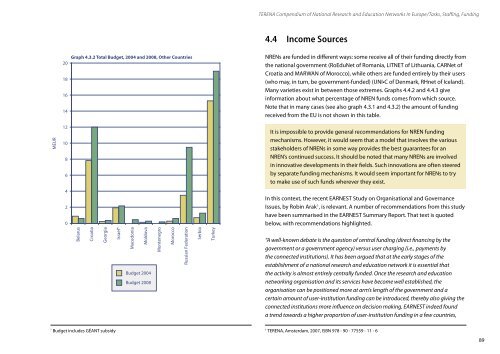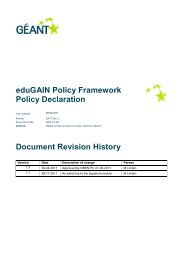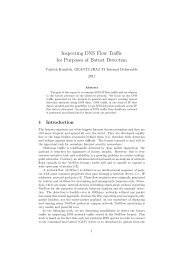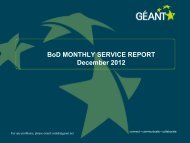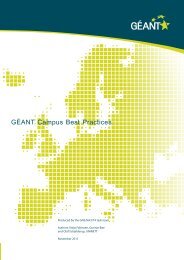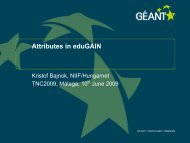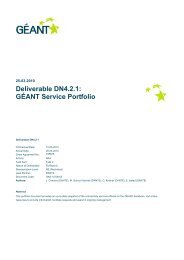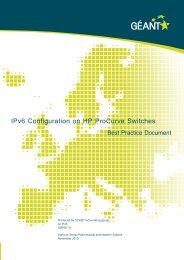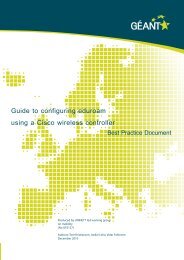TERENA COMPENDIUM - Géant
TERENA COMPENDIUM - Géant
TERENA COMPENDIUM - Géant
You also want an ePaper? Increase the reach of your titles
YUMPU automatically turns print PDFs into web optimized ePapers that Google loves.
<strong>TERENA</strong> Compendium of National Research and Education Networks In Europe /Tasks, Staffing, Funding4.4 Income SourcesGraph 4.3.2 Total Budget, 2004 and 2008, Other CountriesNRENs are funded in different ways: some receive all of their funding directly fromthe national government (RoEduNet of Romania, LITNET of Lithuania, CARNet ofCroatia and MARWAN of Morocco), while others are funded entirely by their users(who may, in turn, be government-funded) (UNI•C of Denmark, RHnet of Iceland).Many varieties exist in between those extremes. Graphs 4.4.2 and 4.4.3 giveinformation about what percentage of NREN funds comes from which source.Note that in many cases (see also graph 4.3.1 and 4.3.2) the amount of fundingreceived from the EU is not shown in this table.It is impossible to provide general recommendations for NREN fundingmechanisms. However, it would seem that a model that involves the variousstakeholders of NRENs in some way provides the best guarantees for anNREN’s continued success. It should be noted that many NRENs are involvedin innovative developments in their fields. Such innovations are often steeredby separate funding mechanisms. It would seem important for NRENs to tryto make use of such funds wherever they exist.In this context, the recent EARNEST Study on Organisational and GovernanceIssues, by Robin Arak 1 , is relevant. A number of recommendations from this studyhave been summarised in the EARNEST Summary Report. That text is quotedbelow, with recommendations highlighted.“A well-known debate is the question of central funding (direct financing by thegovernment or a government agency) versus user charging (i.e., payments bythe connected institutions). It has been argued that at the early stages of theestablishment of a national research and education network it is essential thatthe activity is almost entirely centrally funded. Once the research and educationnetworking organisation and its services have become well established, theorganisation can be positioned more at arm’s length of the government and acertain amount of user-institution funding can be introduced, thereby also giving theconnected institutions more influence on decision making. EARNEST indeed founda trend towards a higher proportion of user-institution funding in a few countries,*Budget includes GÉANT subsidy1<strong>TERENA</strong>, Amsterdam, 2007, ISBN 978 - 90 - 77559 - 11 - 689


